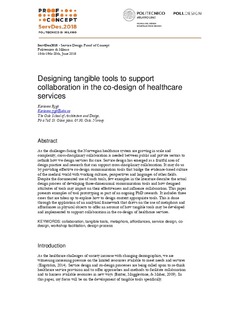Designing tangible tools to support collaboration in the co-design of healthcare services
Chapter
Published version
Permanent lenke
http://hdl.handle.net/11250/2592826Utgivelsesdato
2018Metadata
Vis full innførselSamlinger
Sammendrag
As the challenges facing the Norwegian healthcare system are growing in scale and complexity, cross-disciplinary collaboration is needed between public and private sectors to rethink how we design services for care. Service design has emerged as a fruitful area of design practice and research that can support cross-disciplinary collaboration. It may do so by providing effective co-design communication tools that bridge the evidence-based culture of the medical world with working cultures, perspectives and languages of other fields. Despite the documented use of such tools, few examples in the literature describe the actual design process of developing three-dimensional communication tools and how designed attributes of tools may impact on their effectiveness and influence collaboration. This paper presents examples of tool prototyping as part of an ongoing PhD research. It includes three cases that are taken up to explore how to design context appropriate tools. This is done through the application of an analytical framework that draws on the use of metaphors and affordances in physical objects to offer an account of how tangible tools may be developed and implemented to support collaboration in the co-design of healthcare services. Designing tangible tools to support collaboration in the co-design of healthcare services

